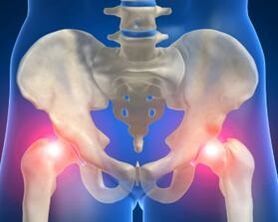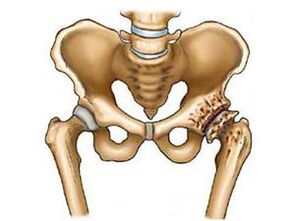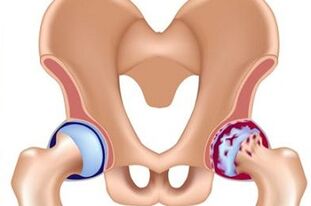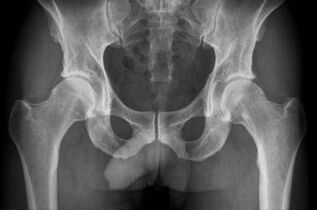
Arthrosis of the hip joint (coxarthrosis) is a chronic and progressive chronic disease, if there is no timely and proper treatment, it can lead to complete loss of movement in it. The end shows that it is not an inflammatory process, but a degenerative process.
The symptoms of this disease vary depending on the stage. Initially, this is a discomfort that may occur while walking and exercising. Probably manifestations in the form of mild pain in the thigh area, which disappears at rest. In this case, the pain can be felt not only in the thighs, but also in the groin or knee.
As a rule, coxarthrosis is a process that has been going on for years, characterized by gradual cartilage changes with subsequent bone deformation and loss of joint function. This mainly affects people after the age of 40, but there are also very young patients.
Cause
Why does hip joint arthrosis occur, and what is it? The causes of coxarthrosis can be different, but the picture of the disease is always the same. It all starts with a change in the articular cartilage, which becomes thinner and loses its ability to absorb load. The body balances the stratification of cartilage tissue with the formation of bone growth along the edges of the articular surface, leading to varying joint and bone deformities.
The main cause of this joint disease:
- Injuries. Such a cause may not be a large lesion, but in many cases the development of the disease is influenced by a chronic microtraum that contributes to the rupture and thinning of the cartilage. They also affect torn joint tears, causing many accumulated injuries. Often, recurrent microtrauma is a precursor to the onset of such a disease.
- Overload, causing systematic microtraumas, as well as joint injuries. Often it occurs in people involved in physical labor or professional athletes. In this case, treatment without lifestyle changes or exercise restrictions is also ineffective and is often accompanied by relapse.
- Hereditary tendencies. These include abnormalities in the development of the femoral head itself, backwardness of the joint elements, and so on. In this case, the so-called dysplastic arthrosis of the hip joint occurs.
- Disease. For example, arthritis, if not treated properly, can develop into arthrosis over time. This is due to the fact that during arthritis, the nature of cartilage tissue changes, and blood circulation is disrupted. This gradually leads to the development of degenerative processes.
- Overweight. Being overweight, even walking, puts a strain on the joints that exceed their physiological strength limits.
Depending on the cause of the disease and its pathogenesis, there are 2 main types of arthrosis of the hip joint.

- Coxarthrosis primer. In this case, the disease develops very slowly and begins with a violation of the blood supply to the tissues. The causes of the development of arthrosis of this type are rooted in metabolic disorders, which are more common in people over 50 years of age. Primary arthrosis of the hip joint is the most commonly diagnosed.
- Secondary coxarthrosis. In this case, the disease develops against the background of systemic inflammatory lesions of many joints in the body. Inflammation can be infectious and autoimmune.
In the early stages of coxarthrosis, patients only think of minor pain or discomfort in the articulatory area. Often such symptoms are ignored, with the outcome of the disease continuing.
Symptoms of hip joint arthrosis
Coxarthrosis of the hip joint, a symptom that can not be ignored, can lead to serious consequences. There are several main signs of this disease, depending on the stage of the disease:
- Pain in the joint area is the most obvious symptom where hip disease can be assumed. The intensity and nature of the sensation usually depends on the stage.
- Limitation of limb movement is also a symptom of coxarthrosis. The initial stage is characterized by a feeling of "stiffness" of the joint, which passes after several attempts.
- Weakness of the thigh muscles can be seen in the second stage of the disease, up to the third stage to resolve atrophy.
- Changes in leg length due to pelvic defects are characteristic of "advanced" osteoarthritis.
- Fatigue or changes in walking style are very likely signs of bone defects.
- Cramps in the joints are not always a sign of arthrosis. Usually taken into account when there are other symptoms.
The main symptoms of coxarthrosis are pain, its nature, duration, localization and intensity depending on the stage of the disease.
Arthrosis of the hip joint 1 degree
The stage of the disease is characterized by pain in the joints and hips, sometimes in the knees, arises after physical exercise and subsides after rest. Joint mobility is unlimited and there are no walking disturbances.
Coxarthrosis degree 1 is the early stage of the disease, initiating treatment of which it is still possible to stop the process of destruction and deformation of the joint and maintain its full function. But, unfortunately, many consider it unnecessary to consult a doctor because of mild pain in the joints, while the disease is currently temporary.
Arthrosis of the hip joint grade 2

It manifests itself more clearly - the intensity of pain increases, it occurs not only after exercise, but also during rest, there are limitations of motor function. In particular, coxarthrosis is characterized by difficulty in pronunciation (rotation into the hip) and abduction, and contractions form.
X-ray examination shows narrowing of joint space and the appearance of bone growth on the surface. Acetabulum and deformed femoral head. The thigh muscles begin to atrophy on the side of the lesion, and the pain syndrome spreads below, capturing the knee joint and groin area (it is important to understand that this will not be accompanied by degenerative changes in the knee joint).
Grade 3 hip arthritis
The symptoms of this disease are significant and permanent. Pain syndrome occurs at night. While walking, patients use support. The muscles of the lower legs and thighs gradually atrophy, and the legs of the sick person become shorter.
Often, in the 3rd degree, the joint space disappears completely, and the joint grows together into a bone structure, this is shown by the picture. As a result, complete joint instability occurs.
Radiography shows extensive bone growth on the lateral side of the acetabulum and head of the femur, sharp narrowing of the joint space. The femoral neck is significantly widened and shortened.
Diagnostics
Before knowing how to treat hip joint arthrosis, it is necessary to make a correct diagnosis. If coxarthrosis is suspected, the person will be referred for a biochemical blood test - if there is a disease, the patient has a slight increase in ESR, globulin, immunoglobulin and seromucoid.
The next step in detecting arthrosis is an X-ray photo. It will reveal:
- cartilage advertising,
- bone growth at the cartilage boundary,
- narrows the distance between joints,
- thickening of bone tissue under cartilage.
Unfortunately, X-ray photos do not make it possible to see for yourself the articular capsule and cartilage, if necessary to get information about this soft tissue, the patient will be referred for a tomography.
Treatment of hip joint arthrosis
When diagnosed with hip joint arthrosis, treatment will directly depend on the degree to which the disease is present. The general treatment regimen provides the achievement of the following goals:
- relieves pain and discomfort in joint pain areas;
- adjust the intra-articular cartilage nutrition and begin the recovery process;
- eliminates intra-articular fluid deficiency;
- activates microcirculation in joint tissue;
- eliminates increased load on the hip joint;
- strengthens the surrounding muscles, protects and supports the joints;
- to prevent deformities and increase mobility in the hip joint.
All of this can be achieved only with the help of an integrated approach, which should include not only drug therapy, but also lifestyle changes to get rid of coxarthrosis risk factors.

- In the third stage of the disease, treatment involves surgery, in which the joint is replaced with endoprosthesis, while part of the prosthesis is inserted into the femur, and part - into the pelvic bone. The operation is quite complicated, time consuming and requires a long recovery time.
- With arthrosis I and II in the hip joint, treatment is carried out without surgery. Used: non-steroidal anti-inflammatory drugs, muscle relaxants, chondroprotectors, vasodilators, hormone steroid drugs, topical drugs - ointments, lotions, compresses.
All of these drugs are prescribed exclusively by the attending physician. Some are effective by injecting directly into the affected articular area. Such injections can only be performed by a qualified medical officer. Therefore, self-medication is not recommended.
Non-drug methods
In addition to the use of medication, doctors also recommend non-drug methods to deal with the disease. This includes the following treatments for this disease:
- physiotherapy;
- urut;
- joint reproduction;
- diet.
Physiotherapy for arthrosis includes the following treatments:
- magnetic therapy;
- UHF and ultrasound therapy;
- aeroionics and electrotherapy;
- inductothermy;
- light therapy;
- laser technology applications.
All these methods can only be used to increase blood supply to the joints and relieve cramps.
Drug therapy
Combined treatment of hip arthrosis involves the appointment of the following groups of drugs:

- Non-steroidal anti-inflammatory drugs, all relieve pain, relieve inflammation, but do not restore cartilage tissue.
- Chondroprotectors. Cartilage nutrition preparation. Accelerate his recovery. Important in phase 1. 2 treatment of arthrosis. In stage 3 of the disease, the cartilage is destroyed, this medicine will not be useful. It takes a long time to take medication, undergo several courses.
- Muscle relaxationeliminates muscle spasms in diseased joint areas, increasing blood supply to tissues.
- Ointments and creams. Healing ointments are a way to alleviate the condition of a sick person, but they do not contribute to full recovery. Heating ointment works well. They irritate the receptors on the skin and thus reduce pain. Warming ointment also works to restore increased blood circulation to the tissues and muscles around the affected joint.
- Steroid injections into the joint cavity, injections of these drugs are prescribed to relieve severe illness and relieve severe pain.
- Vasodilators, dilates the channels in and around the articular cavity, thus increasing the delivery of nutrients needed for tissue repair.
There is no need to rely too much on folk remedies. But some healers recommend the color of lemon, garlic or celery root for joint and bone treatment.
Massage in the treatment of coxarthrosis
If arthrosis of the hip joint is deformed, massage treatment gives good results. Massage for coxarthrosis is a very effective and useful method. It is best to do a massage by a good specialist as often as possible.
Its action aims to improve blood circulation, strengthen muscles, relieve painful cramps, swelling and muscle tension, as well as increase diastasis between the articulatory elements of the joints.
If there is no professional masseur, the massage can be done on your own. Massage for arthrosis can be done manually and with the help of various massage devices as well as water flow (hydrokinesis therapy).
Gymnastics
Treatment of hip joint arthrosis with physical education involves achieving two objectives: to improve leg movement and prevent muscle atrophy. All exercise therapy complexes for coxarthrosis also have general strengthening properties and positive effects on the whole body.
Gymnastics training complexes are prescribed by specialists. The first few physical therapy sessions should be supervised by a physician. He will show you how to do each movement properly, as well as monitor the correct load on the hip joint.
Diet
Key Suggestions:
- Give preference to porridge over water.
- Eat enough animal protein: fish (except salty), chicken, beef.
- Eat at least 5 servings of vegetables a day (one serving is 100 grams, can be used as a side dish).
- Dairy products needed: cottage cheese, yogurt, fermented baked milk.
- Eliminate strong alcohol, coffee, black tea.
- Eliminate sugary and starchy foods.
- Eat small but frequent meals.
Diet will reduce the pressure on the hip joints and give them everything needed for tissue repair.




























